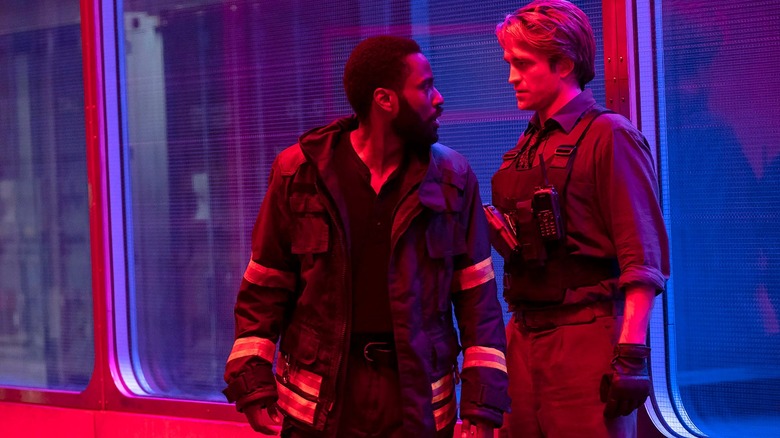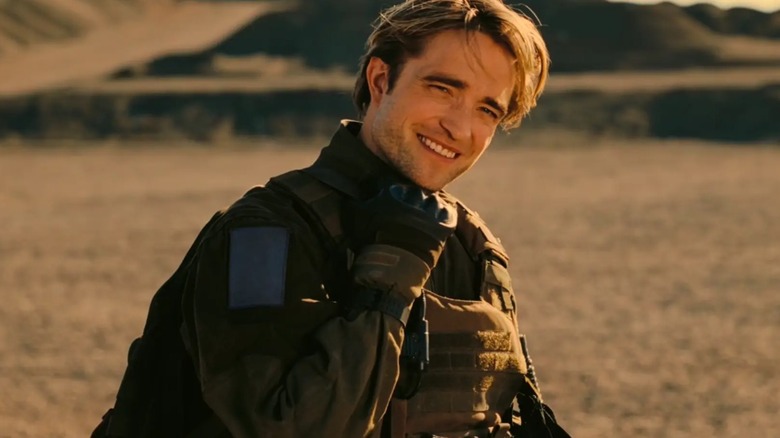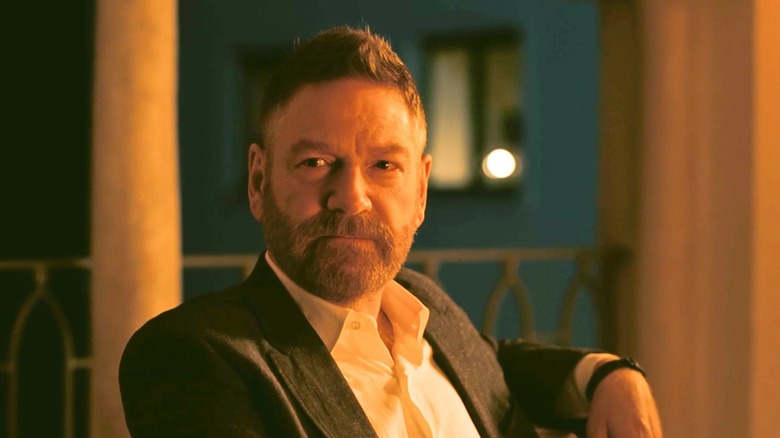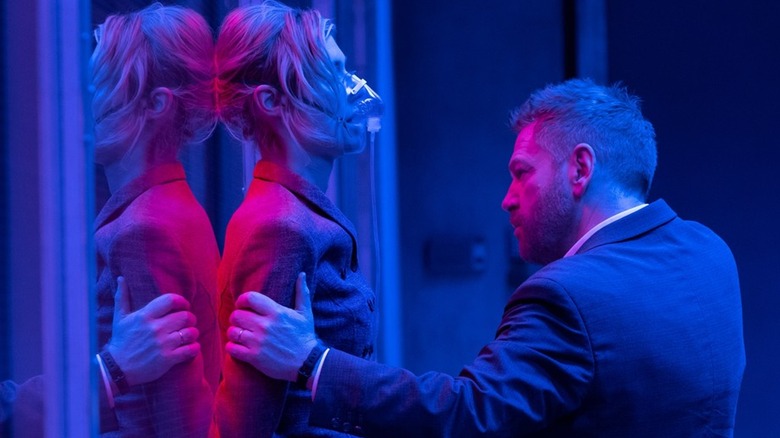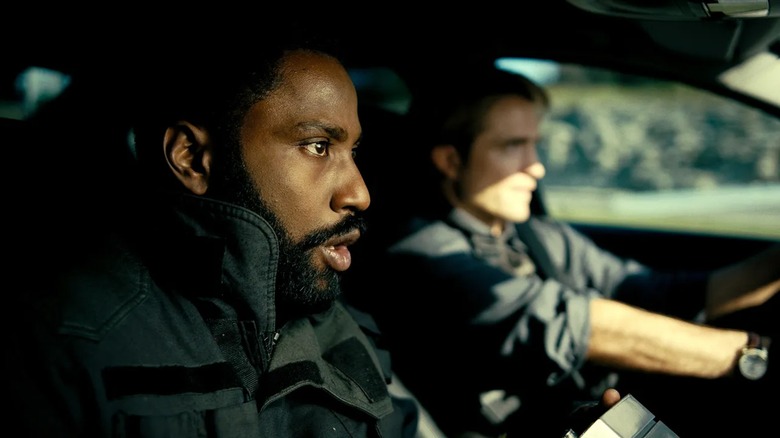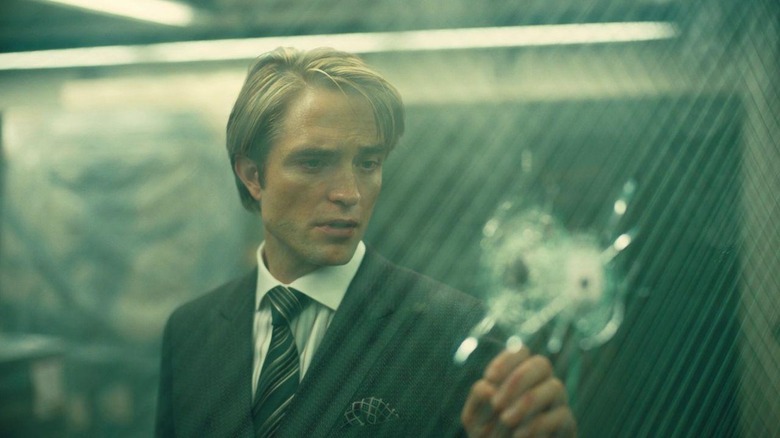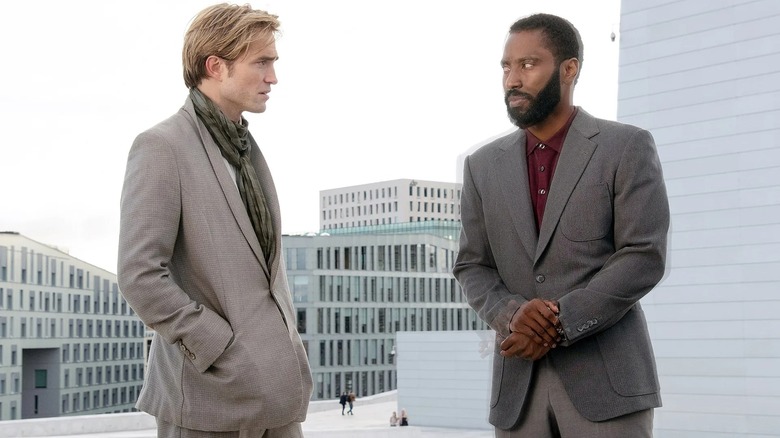The Most Confusing Moments In Tenet, Explained
This post contains spoilers for "Tenet."
Time inversions, palindromes, and temporal pincer movements — these are just some of the concepts that contribute to the wonderfully confusing narrative of "Tenet," which is an experience that benefits the most from repeat viewings. The moment a story defies linear comprehension and flits between different points in time, things get a bit tricky, especially within the context of a mission to preserve the past from the future, where time is being reversed for people to move backward. The events in "Tenet" are palindromic, where moments that move forward and backward in time eventually meet to form a closed temporal loop, where every character is seen participating in multiple timelines until the loop is closed.
The key to understanding "Tenet" is inversion, a process achieved when entropy is reversed, allowing a person or object to move backward in time, as opposed to traditional forward progression. In "Tenet," special machines known as turnstiles facilitate this temporal reversal, leading to scenarios where an individual is simultaneously present in normal and inverted states, where contact between the two can potentially lead to catastrophic anomalies. As temporal loops and flows are inherently confusing by nature, some character trajectories can be rather difficult to map, such as that of Neil (Robert Pattinson), who is intrinsically aware of the temporal loop and uses this knowledge to influence the events of the film.
Although not all questions can be answered, the central mysteries and burning questions in "Tenet" can be solved after piecing together every character's trajectory, both mapped and unmapped, to better understand the themes of predetermination and free will. Here are some of the most confusing moments in "Tenet," explained.
Who saved The Protagonist during the Opera House siege in Kyiv?
The Protagonist (John David Washington) takes part in the Opera House siege in Kyiv to seize the asset as a part of a CIA extraction plan, and he has a coded conversation with a man in a suit before he is compromised. The asset in question is a piece of the Algorithm, but neither The Protagonist nor the audience is aware of this when the events occur, and comprehend its significance in hindsight. A member of the Ukrainian Special Forces asks The Protagonist to place a bomb, and gears to shoot him once he refuses, which is when a masked man saves him using a refracted bullet. This is one of the first instances of refraction (caused by inversion) witnessed by The Protagonist, and he is able to glimpse one distinctive feature about his savior: a backpack with a coin dangling by a red thread.
This particular backpack crops us again when The Protagonist and Ives (Aaron Taylor-Johnson) are trapped inside the cave, where they see one of Andrei Sator's (Kenneth Branagh) men holding the Algorithm machine. If the machine is turned on, it will spell the end of the world, and The Protagonist is unable to reach the goon due to a closed metal gate and is about to be killed. Just when all hope seems lost, a corpse sporting the backpack reanimates and opens the gate, sacrificing himself and saving the world in the process. This person who saves him time and again is Neil (Robert Pattinson), who reveals that they meet in the future and become friends, where The Protagonist founds the TENET organization and recruits Neil to travel backward in time to ensure that the mission to save the world goes according to plan.
How did Andrei Sator establish contact with the future?
Russian Oligarch Sator is first brought up by arms dealer Priya (Dimple Kapadia), and we gradually learn that Sator originally hails from Stalsk-12, a closed city with restricted infrastructure bordering on being a secretive, invisible settlement. This is where Sator first makes contact with the future conspirators as a young man, who recruits him to aid their mission to erase the past to prevent the extreme environmental degradation and disasters that grip the future. Being trapped in circumstances that only sharpened his misanthropist tendencies, Sator decides to aid them in exchange for inverted gold, allowing him to become the influential man he is in the present. With their help, Sator gathers eight of the nine pieces of the Algorithm, a device that will trigger the world's annihilation when Sator flicks the dead man's switch.
As Sator will perish anyway due to his terminal illness, this acts as added fuel for his hatred for humanity, as he states that he would not want future generations, such as his son Max, to live in a world headed toward catastrophe. As those in the future have already mastered time inversion, they contact Sator by traveling backward in time to convince him to help them set their plan in motion. The scientist from the future who designed the Algorithm eventually realized the dangerous nature of the device and hid parts of it in the past, and Sator's mission is to retrieve and piece them together. While he succeeds in gathering eight pieces offscreen, the final asset becomes the bone of contention in "Tenet," as we see him and The Protagonist wrestle for this key piece that dictates the fate of the world.
How do Neil and The Protagonist save Kat?
A plutonium heist leads to a highway chase in Tallinn, involving a box containing an asset similar to the one in Kyiv, a flipped silver car, and a car speeding backward. Once Neil and The Protagonist are captured inside Sator's facility, Sator's wife, Kat (Elizabeth Debicki), is shot with an inverted bullet right before Ives' men charge in and take control of the turnstile. To save her life, The Protagonist and Neil wheel Kat through the turnstile to invert all three of them (to reverse entropy and prevent Kat from dying due to a fatal bullet wound). This inversion in time loops back to the day of the Norway Freeport heist in Oslo, where a ton of fighting occurs until Neil manages to wheel Kat through the turnstile there, allowing her to move forward in time again and become stabilized in the process.
The inverted journey to Oslo answers many burning questions that we, and The Protagonist have when he first encounters and fights a masked man emerging from the turnstile at the Freeport. The inverted Protagonist views the events from a fresh perspective, fighting his past self (who is moving forward in time), while it is revealed that past Neil also fought a future version of The Protagonist (who is also moving forward, having used the turnstile at the Freeport after the inversion at Tallinn). As Neil is aware of his role in the mission, he lets the reversed Protagonist go and prevents The Protagonist from killing his future inverted self, as hindering him would only mess with the flow of events. Essentially, the three inverted people — Kat, Neil, and The Protagonist — use the Oslo turnstile to move forward in time and close this part of the loop, heading towards what occurs next.
What is the significance of the Temporal Pincer at Stalsk-12?
The closing setpiece in "Tenet," the Temporal Pincer Movement, is a military operation that uses the traditional pincer movement to attack Sator's men from both sides, closing in on them like a pincer for maximum impact. A temporal pincer involves two teams moving in different directions in time, with Team Red moving forward (non-inversion) and Team Blue moving backward while wearing oxygen masks (inversion). With the two teams closely syncing their attacks, The Protagonist and Ives are free to enact their mission to extract the Algorithm machine. Neil, who is moving backward as a part of Team Blue, notices an inverted goon laying the trap near the cave but fails to alert them on time, which forces him to use the turnstile and save the two before the epicenter explodes.
This is when The Protagonist and Neil talk about their shared past and future, where Neil reveals that this is the end for him, but the beginning for The Protagonist, as the latter is yet to experience his friendship with Neil in the future. While a non-inverted Neil has saved him and Ives from the cave collapse, he still has to close the loop and invert himself again to travel backward to save The Protagonist from being killed inside the cave — a necessary sacrifice to ensure that the past is preserved and that he fulfills his mission as a TENET operative with the temporal flow of the future (which allows for Neil's time inversion to occur in the first place) intact. This moment marks the end of Neil's life, but not his temporal trajectory, as the Protagonist will meet Neil again for the "first" time in the future and recruit him to his cause.
What did the car chase in Tallinn accomplish?
Ives' military ambush at Stalsk-12 is not the only instance of a temporal pincer, as this move is executed by Sator at several points, including during the Tallinn heist. When we first experience the sequence linearly (from Neil and The Protagonist's point of view), they're able to secure the final piece of the Algorithm, but suddenly witness an Audi in reverse. Inside, Sator holds Kat at gunpoint, just as an overturned car flips back up — this precarious situation forces The Protagonist to hand over the case, which he slides over by using the second car as a springboard. The sequence culminates in Kat being saved from the moving car and everyone being captured for interrogation.
Later, after the characters are rescued by Ives, we learn that the other car at the scene — which The Protagonist had leveraged to slide the box over to Sator — was helmed by an inverted Protagonist intent on saving the day. However, Sator is quick to figure this out and confronts the inverted Protagonist inside the car and sets it on fire, which ends up inducing hypothermia as entropy is reversed in inverted objects and people. After Neil saves him, it becomes clear that the case the non-inverted Protagonist has slid to Sator was a bugged dupe, as the real case was covertly thrown inside the inverted car to his inverted self from the future when he carried out the maneuver. While this should have worked, Sator is able to track the trajectory of the inverted car hiding the case back to the Oslo Freeport, and extract it, as moving backward in time was all it took to do so. This makes The Protagonist realize that inversion cannot necessarily alter the past in the way theoretical time travel can.
Why and how do people in the future plan to overwrite the past?
To understand the motivations of those in the future, it is crucial to understand that "Tenet" does not subscribe to the traditional understanding of time travel, but leans heavily into time manipulation with its inversion mechanic. The scientist who invented inversion regretted it, as the pieced-together Algorithm would completely inverse the flow of time on Earth, causing a perpetual and neverending inversion for everything. Even without getting into the scientific nuances of it all, it is enough for us to deduce that this is, well, bad — but people in the future believe that this time reversal will allow them to undo climate change devastation and hide in the past. This does not mean that the past will be changed enough to alter the future, but that the temporal makeup of the past will be tuned up enough for the future to take refuge in it.
This brings us to the how, in the sense of temporal causality, where any manipulations of the past could potentially lead to the future ceasing to exist due to the paradoxes of breaking the space-time continuum. While this is a threat at certain points, the world of "Tenet" hinges on an ontological paradox, which follows the logic that the past can be altered because it had always been altered, where any changes are already a part of a causal loop. No new timelines are ultimately created even though branched timelines crop up with inverted trajectories, as every temporal loop is eventually closed to ensure that things that have happened, happen. A good example is Neil inverting himself after saying goodbye to The Protagonist at Stalsk-12, as he has to close the loop of his trajectory to preserve the past and the future.
Confusing stray concepts: TENET and the SATOR square
A palindrome is a word or phrase that reads the same forward or backward, and "TENET," both the title of the film and the organization that The Protagonist establishes in the future to preserve the past, is one such palindrome that underlines the two-way flow of time. As the past and the future unfold at the same time at several points in the film, where characters from different points in time move around to manipulate it in their favor, the palindromic nature of "Tenet" becomes more pronounced with the temporal pincers executed as a means to control time. The Kyiv operation that the film opens with takes place on the 14th, and so does the Stalsk-12 operation, making it clear that the loop is effectively opened and closed on the same day.
Another example of a palindromic device used throughout is the SATOR square, a 5x5 interlocking cryptogram of Latin palindromes that spell out the words Sator, Arepo, Rotas, Opera, and Tenet. All of these words are integral parts of the narrative — the Opera siege is the trigger event for the loop, Sator is the mastermind behind the plan to destroy the world, and Tenet is the organization opposing him. Meanwhile, Arepo is the name of the art dealer who urged Kat to sell the forged Goya painting to Sator, and Rotas is one of Sator's many companies. Tenet is the only word on the SATOR tile that is a palindrome, which explains why The Protagonist might have chosen to name his organization after a world that essentially means to master, preserve, and sustain. In this case, these sentiments apply to the fate of the world, where the past and the future meet time and again.
